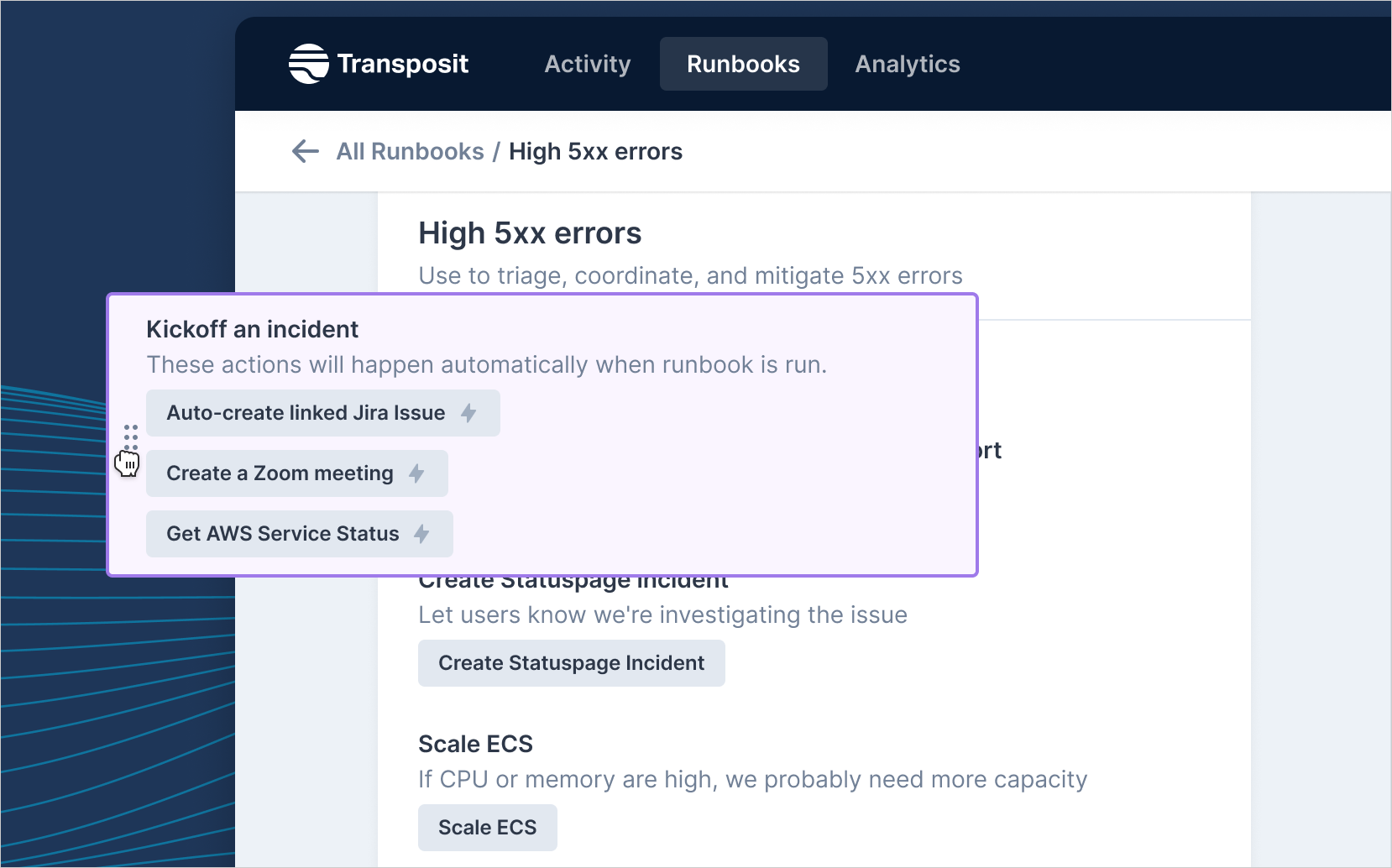No-Code Runbook Builder Drives Automation Forward Across Digital Operations
New features & functionality provide the flexibility, customization,
and visibility to drive operational excellence

The explosion of SaaS tools, disjointed workflows and documentation, and lack of visibility into the moving parts throughout operations is exacerbating the division between dev and ops teams. Dev teams want to move fast and stay agile, and ops teams need to ensure governance and guardrails. DevOps process orchestration has the power to bridge this gap by bringing together siloed tools, data, and people under one common theme.
New Transposit features and functionality create an even more powerful solution, adding deeper no-code customization, flexible orchestration, and operational visibility. We’re empowering developers and non-developers alike to create sophisticated workflows across their stack and incrementally automate processes, all while maintaining visibility across their toolchain.
Today’s release ensures that everyone within an organization, including stakeholders and non-developers, can use the power of process orchestration to bring calm to the chaos and deliver value faster.
See Transposit in Action#
No-Code Runbook Builder Empowers Non-Developers to Automate Processes#
We believe that orchestrating the many moving parts of a system shouldn’t require dedicated staff with specialized knowledge of the tool. So we made that belief a reality. Our new no-code runbook builder gives anyone across the organization the ability to create sophisticated human-in-the-loop automated workflows — without writing a single line of code.

The runbook builder is truly built for all to use — just plug in a series of steps and easily move, add, or delete steps as needed. You can also add actions into steps, which connect your tools and services to runbooks and facilitate immediate actionability without jumping between tools. Transposit has hundreds of pre-built actions that teams can use and connect to runbooks to reduce manual toil and streamline operations.
For even deeper customization, the developer platform provides code-based customization in common languages like Python, Javascript, or SQL. From no-code to code, Transposit is empowering teams to codify and automate processes to fit their unique needs.
Triggers for Runbooks & Actions Accelerate Event Response#
New triggers for runbooks and actions enable highly flexible event-driven response automation that blends human and machine triggers and accelerates response to any event. While some processes may be ripe for end-to-end automation, most will combine humans and machines. Transposit runbooks amplify the unique powers of both, enabling machines to automate repetitive, predictable tasks while keeping human checkpoints for when context and judgment is needed.
New features allow users to trigger runbooks based on conditions like activity type, severity, originating webhook, and/or metadata. Triggers for actions within runbooks can be executed immediately upon a runbook starting or after a previous action has been completed.
Activity Feed Enhances Operational Visibility#
As complexity increases, both operations teams and their stakeholders need better visibility into all the moving parts — the status of incidents, what changes are happening, and how problems are being resolved. There are so many teams and individuals taking action at any given point that getting a high-level view can be difficult. Until now.
Transposit’s new activity feed provides the visibility operations teams need to ensure governance and process controls while simultaneously giving stakeholders the information they need in one centralized place.
This intelligent view into all the activities happening throughout the pipeline and infrastructure ensures that teams can quickly understand what’s happening across services and what needs their attention. It pulls together important events across every tool such as alerts, requests, and CI/CD systems as well as high-level activity within Transposit.
Customizable Postmortem Export Drives Continuous Improvement#
After recovery from an incident, piecing together what happened, who participated, and the entire timeline of events is time-consuming and tedious. Transposit’s new customizable postmortem export ensures teams have the accurate and comprehensive data from both humans and machines to thoroughly investigate incidents, execute root-cause analyses, and ultimately drive continuous improvement.

After recovery, teams can export any or all events from the incident timeline into a Google Doc or Confluence page. The postmortem provides links back to each dashboard update so teams can easily dig deeper into parts of the incident timeline.
More Powerful, Flexible DevOps Process Orchestration#
Today, orchestrating the many moving parts within operations is easier than ever. All together, Transposit’s new features and functionality are enabling engineering and operations to work more cohesively together to achieve their goals. Our mission is to bring calm to the chaos for modern operations, enabling teams to incrementally automate processes while maintaining end-to-end visibility across operations.
 Jessica Abelson, Group Product Marketing Manager · Jun 21st, 2021
Jessica Abelson, Group Product Marketing Manager · Jun 21st, 2021